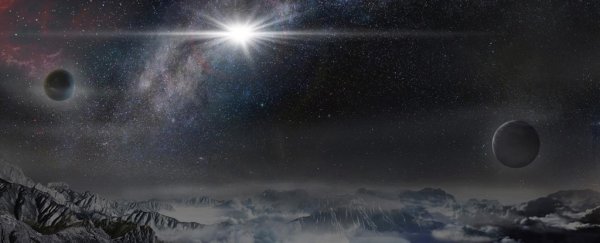Last June, a team of astronomers armed with a network of telescopes across the globe spotted an unusually bright object, and upon further investigation, discovered that they had stumbled on the most powerful supernova on record. What's more, experts think that they might never see a supernova this bright ever again.
Supernovae are a type of cosmic explosion generated by high-mass stars, usually those which are nearing the end of their lives. The explosion annihilates most of the star as well as anything nearby. While your average supernova generates roughly 1044 joules of energy – about the same amount that our Sun produces over 10 billion years – a super-luminous supernova, like the one discussed here, can explode with up to 50 times more energy.
This particular super-luminous supernova, called ASASSN–15lh, doesn't just break the record for most powerful – it obliterates it. On average, it outshines the average supernova by 200 times, the team reported in a paper published in this week's issue of Science.
This goes so beyond the norm that one of the astronomers who first observed it wasn't sure what to make of it.
"To my surprise, I was not able to even tell for sure it was a supernova. My first reaction was: 'This is interesting, we should get more data'," Nidia Morrell, who works with the Las Campanas Observatory in Chile and is a co-author on the paper, said in a press release. "It was only when we obtained higher resolution [data] from the Southern African Large Telescope and the Magellan Clay Telescope that I realised how distant the host galaxy is and, consequently, how luminous the supernova."
Unfortunately, we could never have hoped to see the explosion with our naked eye because its source is so distant – it's coming from a galaxy 3.8 billion light-years away. Here's what that galaxy looked like, through a telescope, before (left) and after (right) the explosion:
 The Dark Energy Survey, B. Shappee and the ASAS-SN team
The Dark Energy Survey, B. Shappee and the ASAS-SN team
The network of telescopes, named the All Sky Automated Survey for Supernovae (ASASSN), is meant to sniff out bright objects like these, and has discovered over 250 supernova.
At peak intensity, astronomers calculated the signal to be shining with a mind-boggling intensity 570 billion times brighter than our Sun. For a better idea of how bright that is, if you could combine all 100 billion stars in our Milky Way Galaxy into one enormous glowing sphere, this super-luminous supernova would still shine 20 times brighter.
"We have to ask, how is that even possible?" Krzysztof Stanek, who is the team's co-principal investigator and a professor at Ohio State University, said in a press release. "It takes a lot of energy to shine that bright, and that energy has to come from somewhere."
A long-standing mystery
Stanek's question gets at the heart of a mystery that's been perplexing astronomers for over a decade, ever since they first began searching the skies for these super-luminous events at the end of the '90s. They want to know what physical processes are at work that cause explosions so beyond anything we can fathom on Earth.
Generally, astronomers think they have a good handle on what causes your average supernova, but when it comes to hypernovae (another name for super-luminous supernova), they're somewhat stumped.
"The honest answer is, at this point, that we do not know what could be the power source for ASASSN–15lh," Subo Dong, the paper's lead author and an astronomy professor at Kavli Institute for Astronomy and Astrophysics at Peking University, told Ohio State.
One theory is that a type of extremely dense star, called a neutron star, is at the source of it all. Neutron stars are some of the densest objects in the universe and are thought to be the only thing that's left of a star once it's gone supernova.
Many neutron stars are believed to be spinning on their axis – the same way Earth rotates on its axis. And in some neutron stars, the spinning action is so fast that it spawns powerful magnetic fields. Astronomers call these cases magnetars.
One theory is that the magnetic fields of magnetars are so strong that they could fuel the power necessary to generate the intense luminosity of observed hypernova. But if this is the case, it would also mean that in order to produce the type of luminosity seen from ASASSN–15lh, the magnetar would have to be spinning at 1,000 times a second.
"Given those constraints… Will we ever see anything more luminous than this?" Todd Thompson, who is professor of astronomy at Ohio State but wasn't part of the team, said in a press release. "If it truly is a magnetar, then the answer is basically no."
This article was originally published by Business Insider.
More from Business Insider:
